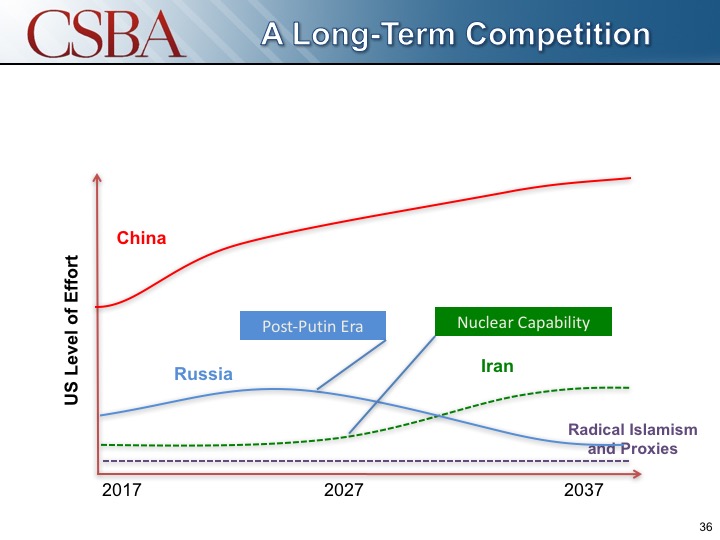414 Ships, No LCS: MITRE’s Alternative Navy
Posted on
WASHINGTON: The Navy needs a vastly larger fleet — 414 warships — to win a great-power war, well above today’s 274 ships or even the Navy’s unfunded plan for 355, the think-tank MITRE calculates in a congressionally-chartered study. That ideal fleet would include: 14 aircraft carriers instead of today’s 11; 160 cruisers and destroyers instead… Keep reading →
Big Wars, Small Ships: CSBA’s Alternative Navy Praised By Sen. McCain
Posted on
UPDATED with McCain praise WASHINGTON: The Navy needs a bigger fleet of smaller ships than envisioned in its official Force Structure Assessment, says a congressionally-chartered study from the Center for Strategic & Budgetary Assessments. CSBA emphatically agrees with the Navy that the focus needs to shift from day-to-day counter-terrorism and presence operations to deterring (and if need be,… Keep reading →
Why Mattis Headed East: Time For China Strategy
Posted on
Why is newly confirmed Defense Secretary Jim Mattis making his first overseas trip to the Western Pacific to confer with two of America’s key allies, Japan and South Korea? After all, both Mattis and Gen. Joe Dunford, Chairman of the Joint Chiefs of Staff, have declared Russia poses the greatest danger to the United States. But… Keep reading →
Fear China Most, ‘Flip’ Russia, Beware Iran: CSBA
Posted on
WASHINGTON: Wealth, population and thin-skinned nationalism make China the number one threat to the US-led world order, not Russia or Islamic terrorism, writes leading military strategist Andrew Krepinevich. That means the US must build up forward-deployed forces in the Western Pacific, he writes, if necessary at the expense of defending Europe. Russia’s oil-dependent economy and… Keep reading →
Fixing The Ford, Getting Creative With Carriers
Posted on
This week, the Navy finally announced a delivery date for the long-delayed and $2.4 billion over-budget aircraft carrier, the Gerald Ford (CVN-78). “In hindsight,” said Adm. Thomas Moore, head of Naval Sea Systems Command, the Navy should have tested the Ford’s ambitious new systems more extensively on shore before installing them aboard ship. But building a… Keep reading →
Best Of 2016: The Next War
Posted on
What will the next war look like? Robots, lasers, hypersonic missiles, and stealth aircraft figure prominently, but what matters most isn’t the technology: It’s the concepts of operation that bring them all together — just as the German blitzkrieg combined tanks, aircraft, and the radio, or the Japanese at Pearl Harbor combined aircraft and ships.… Keep reading →
The 355-Ship Fleet Will Take Decades, Billions To Build: Analysts
Posted on
WASHINGTON: The Navy’s new Force Structure Assessment calling for a 355-ship fleet puts an important intellectual arrow in Donald Trump‘s quiver as he campaigns for more ships. But it doesn’t put any more money in the budget to buy them, or any more machinery in shipyards to build them. The Navy analysis will shape the… Keep reading →
A Bridgehead Too Far? CSBA’s Aggressive, Risky Strategy For Marines
Posted on
UPDATED with Brig. Gen. Turner remarks on the report WASHINGTON: Marines are famously aggressive, but a new battle plan from a leading thinktank makes Iwo Jima look low-risk. The Center for Strategic & Budgetary Assessments’ proposed concept of operations is imaginative, exciting and more than a little scary: In a future war, rather than stay far… Keep reading →
Army’s Multi-Domain Battle To Be Tested In PACOM, EUCOM Wargames
Posted on
ARLINGTON: Harry Harris has to be the Army’s favorite admiral. The chief of Pacific Command has called for Army-owned anti-ship missiles. He has enthused over the Army’s new warfare concept, and now he is planning a major inter-service exercise to work out what that Multi-Domain Battle concept means in practice. “We are starting to put… Keep reading →
Marines Seek To Outnumber Enemies With Robots
Posted on
PENTAGON CITY: Since World War II, the US military has always expected to fight outnumbered. Soon, however, expendable unmanned systems may change that. For the first time in 70 years, America could have numbers on its side. That turns traditional assumptions about tactics, technology, and budgets upside down. “It does flip things,” said Lt. Gen.… Keep reading →










